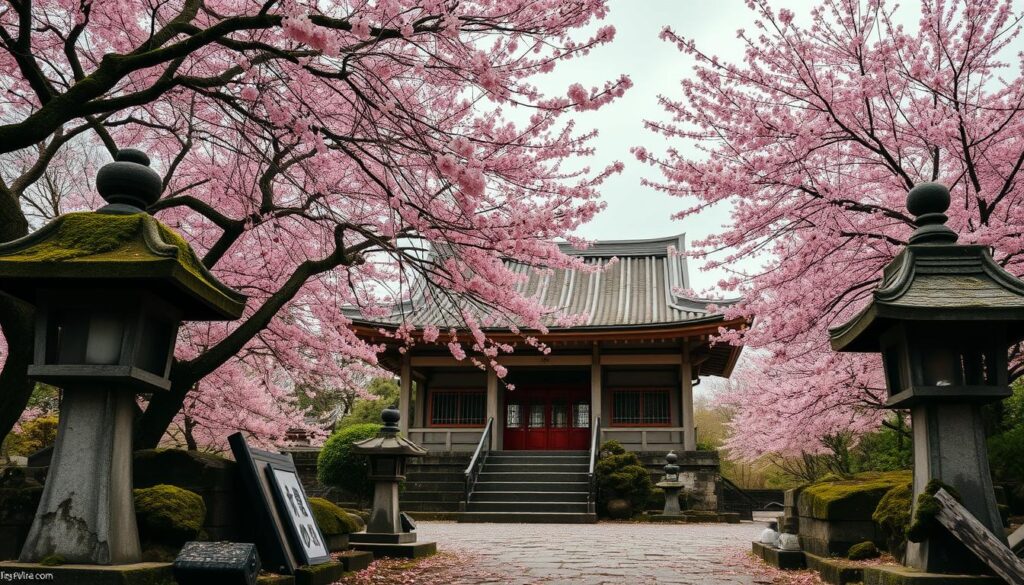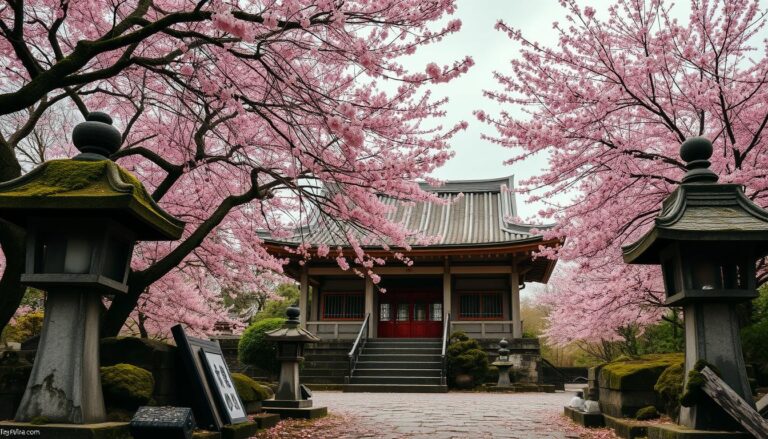broken and beautiful japon is a country with a rich history and vibrant culture. It’s known for its stunning landscapes, making it a fascinating place to visit. The country beautifully mixes old traditions with modern life, offering a unique experience.
From busy cities to quiet rural areas, broken and beautiful japon has a lot to see. It’s home to many hidden treasures that are waiting to be discovered.

A serene Japanese landscape featuring a cracked, weathered temple surrounded by vibrant cherry blossom trees, delicate petals falling in the wind, with ancient stone lanterns partially overgrown by moss, contrasting the beauty of nature with the remnants of time.
Modern broken and beautiful japon is full of surprises, blending the old with the new. Visitors can explore its history, culture, and landscapes. They can discover what makes Japan so fascinating, including its hidden treasures.
The Dual Nature of Modern broken and beautiful japon
Modern broken and beautiful japon is a mix of old and new. You see this in its buildings, art, and culture. The wabi-sabi philosophy celebrates the beauty of things that are imperfect and short-lived.
In Japan, old and new live together peacefully. Ancient temples and shrines are next to modern skyscrapers. This shows how the wabi-sabi philosophy adds to the beauty of these structures.
- Traditional festivals and celebrations, which showcase the country’s rich cultural heritage
- Modern technology and innovation, which drive the country’s economy and industry
- The concept of wabi-sabi philosophy, which emphasizes the beauty of imperfection and impermanence
Understanding Japan’s dual nature helps us appreciate the beauty of imperfection. It also shows the value of keeping traditional culture alive in today’s fast-changing world.
| Aspect | Traditional Japan | Modern Japan |
|---|---|---|
| Architecture | Ancient temples and shrines | Modern skyscrapers and buildings |
| Art | Traditional paintings and pottery | Modern art and digital media |
| Culture | Traditional festivals and celebrations | Modern technology and innovation |
Exploring the Broken and Beautiful Japon Through Urban Landscapes
broken and beautiful japon cities are a mix of old and new, with urban landscapes that show off the country’s culture. You can see the bright lights of Tokyo or the old temples of Kyoto. These cities offer many exciting things to see and do.
The modern architecture in Japan’s cities shows the country’s creativity and focus on details. The buildings are sleek and use the latest technology. At the same time, the old temples and shrines give a peek into Japan’s past.
Some key parts of Japan’s urban landscapes include:
- Vibrant neighborhoods, such as Tokyo’s Shibuya and Osaka’s Dotonbori
- Stunning architecture, including the Tokyo Tower and the Kyoto Imperial Palace
- Rich cultural heritage, with numerous temples, shrines, and museums
Japan’s cities are special because they mix old and new. They have history, architecture, and food to explore. With their rich culture and modern comforts, Japan’s cities are a top spot for anyone wanting to see the broken and beautiful Japon.
| City | Population | Must-see Attractions |
|---|---|---|
| Tokyo | 13.9 million | Shibuya Crossing, Tokyo Tower, Meiji Shrine |
| Osaka | 2.7 million | Dotonbori, Osaka Castle, Universal Studios Japan |
| Kyoto | 1.5 million | Kyoto Imperial Palace, Fushimi Inari Shrine, Kinkaku-ji Temple |
Hidden Temples and Forgotten Shrines broken and beautiful japon
broken and beautiful japon is full of temples and shrines, many hidden in rural areas or lost in cities. These sacred spaces show Japan’s deep cultural and spiritual roots. From old buildings in cities to quiet religious sites in the countryside, Japan’s hidden spots are full of history and culture.
Some hidden temples are found in surprising places, like city streets or rural areas. Others are covered in vines and moss, blending with nature. These sacred spaces are important for their history and beauty.
Visitors can find peace in these forgotten shrines. Many are still used for religious events, giving a rare look at Japan’s spiritual side. Whether you love history, culture, or nature, Japan’s hidden temples and shrines are a must-see.
Discovering Rural Religious Sites broken and beautiful japon
- Explore ancient structures in modern cities
- Visit rural religious sites off the tourist trail
- Experience the natural beauty of sacred spaces reclaimed by nature
By visiting these hidden temples and forgotten shrines, you learn more about Japan’s culture and spirituality. So, why not explore these sacred spaces and see their beauty and importance for yourself?
The Poetry of Abandoned Places broken and beautiful japon
broken and beautiful japon rural areas are filled with abandoned places, each with its own story. These spots, marked by urban decay, show the country’s history and culture. From abandoned villages to urban decay, they offer a wealth of poetic inspiration and cultural insight.
In Japan’s countryside, you’ll find old factories, schools, and homes left empty. These places, once bustling, now stand as a reminder of economic and social challenges. The decay here highlights the fleeting nature of human projects and nature’s reclaiming power.
Despite their neglect, these places have a unique beauty. The peeling paint, overgrown gardens, and crumbling walls tell stories of the past. Here, one can find peace and tranquility, away from today’s fast pace.
Some notable abandoned spots in Japan’s countryside include:
- Old mining towns, abandoned after the mines were closed
- Ghost villages, where people moved for work
- Abandoned schools, showing rural community decline
These places, though abandoned, hold a special place in many Japanese hearts. They remind us of Japan’s history and culture, and the people’s resilience and determination.
| Location | Type of Abandoned Place | Year Abandoned |
|---|---|---|
| Nagano Prefecture | Old mining town | 1960s |
| Fukushima Prefecture | Ghost village | 2011 |
| Okayama Prefecture | Abandoned school | 1990s |
Cultural Contradictions in Contemporary Society broken and beautiful japon
broken and beautiful japon is a country where old and new meet. It blends traditional values with modern life in a special way. This mix shows in how people live their daily lives, caught between old customs and new social norms.
In today’s world, people face cultural contradictions every day. They try to keep traditional values alive while living in a fast-changing society. For example, the Japanese respect their elders but also love new technology. This mix of old and new has created unique social norms in Japan.
Some key parts of Japanese culture show these contradictions. For example:
- They keep traditional festivals like the Cherry Blossom Festival and the Tea Ceremony alive.
- Modern social norms, like tattoos and piercings, are becoming more accepted.
- There’s a debate on preserving historic buildings versus building new ones.
As Japan moves forward, these cultural contradictions will likely stay. By accepting these differences, Japan can keep being a unique and interesting place. It will continue to blend traditional values with modern life and social norms.
Natural Wonders Beyond the Iconic broken and beautiful japon
Japan is full of natural wonders, from famous Mount Fuji to hidden national parks and secret hot springs. These wonders show off Japan’s unique geology and biodiversity. They highlight the beauty of Japan’s natural world.
The Japanese Alps are a must-see, with their stunning landscapes and trails for hiking. Japan also has many national parks, like Nikko and Yoshino-Kumano. These parks offer a peek into Japan’s unique plants and animals.
Exploring Hidden Gems
Looking for more than just famous spots? Japan has many hidden gems. The country is home to many hot springs, or onsen. These offer a chance to relax and refresh in natural hot water, surrounded by beautiful views.
Japan’s hidden valleys, like Kamikochi Valley, are also worth a visit. They have amazing views and trails for hiking. Here, you can see stunning scenery and spot local animals like deer and monkeys.
- Nikko National Park
- Yoshino-Kumano National Park
- Japanese Alps
- Kamikochi Valley
- Hot springs in the Japanese Alps
| Natural Wonder | Location | Description |
|---|---|---|
| Nikko National Park | Tochigi Prefecture | A national park known for its scenic lakes, waterfalls, and hiking trails |
| Yoshino-Kumano National Park | Nara Prefecture | A national park known for its scenic valleys, waterfalls, and hiking trails |
| Japanese Alps | Nagano Prefecture | A mountain range known for its stunning scenery and scenic hiking trails |
The Art of Impermanence
Impermanence is a key idea in Japanese culture, seen in many Japanese art forms. The wabi-sabi philosophy celebrates the beauty of things that are imperfect and short-lived. This view shapes Japanese art, literature, and daily life.
Japanese art often uses natural images, like cherry blossoms, to show life’s fleeting nature. The traditional Japanese tea ceremony also highlights the importance of the moment. Famous writers like Matsuo Bashō and Yosa Buson often write about life’s impermanence.
The wabi-sabi philosophy influences many Japanese art types, from pottery to manga and anime. This focus on imperfection and change has led to unique and engaging art. Japanese art’s unique character, born from embracing impermanence, inspires artists globally.
Some key aspects of the art of impermanence in Japan include:
- The use of natural materials and imagery
- The emphasis on simplicity and subtlety
- The appreciation of imperfection and impermanence
The art of impermanence is not just about creating something beautiful, but about embracing the fleeting nature of life and the impermanence of all things.
Conclusion: Embracing Japan’s Perfect Imperfections
Our journey through japon has shown us Japan’s unique cultural heritage. It’s all about perfect imperfections. The country mixes tradition and modernity in a way that’s both haunting and serene.
The heart of Japan’s cultural heritage is its love for imperfection. This is called wabi-sabi. It’s about finding beauty in things that are imperfect, short-lived, and simple. This philosophy is seen in Japanese art and architecture.
As we end our look at broken and beautiful japon, we gain a new respect for Japan. Its perfect imperfections show its strength and beauty. Japan has faced many challenges and come out stronger and more beautiful.
FAQ
What makes Japan’s hidden treasures so unique?
Japan is famous for its rich history, vibrant culture, and beautiful landscapes. It has bustling cities and peaceful rural areas. The country mixes old and new, offering a unique experience to visitors.
What is the concept of wabi-sabi philosophy and how is it reflected in Japanese culture?
Wabi-sabi philosophy values the beauty of imperfection and change. It’s seen in Japanese architecture, art, and more. Understanding wabi-sabi helps us appreciate the beauty of imperfection and the fleeting nature of life.
What are some of the unique aspects of Japan’s urban landscapes?
Japan’s cities are alive with energy, stunning buildings, and a rich history. Places like Tokyo and Kyoto show a mix of old and new. This mix reflects Japan’s cultural heritage.
What are some of the hidden temples and forgotten shrines in Japan?
Japan has many temples and shrines, some hidden in rural areas or forgotten in cities. These places offer a peek into Japan’s cultural and spiritual past. They include ancient buildings in modern cities, rural sites, and nature-claimed spaces.
What are the cultural contradictions in contemporary Japanese society?
Japan balances tradition and modernity, creating cultural contradictions. It values old customs but also embraces new ideas. This mix is seen in its social norms, values, and the push for progress.
What are some of the lesser-known natural wonders in Japan?
Japan has more than just Mount Fuji. It has hidden national parks, secret hot springs, and valleys. These spots show Japan’s unique geology, biodiversity, and cultural heritage.
How is the concept of impermanence reflected in Japanese art and aesthetics?
Impermanence is a big part of Japanese culture, seen in art and aesthetics. It’s shown in the short life of cherry blossoms and the fleeting nature of life. This theme is tied to the wabi-sabi philosophy.
